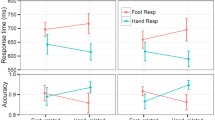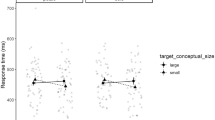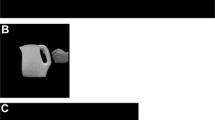Abstract
The present study aimed to determine whether the representation of object affordances requires specification of the effector potentially interacting with the object: specifically, in this study, vision of the interacting hand. In Experiment 1 we used an apparatus by which a fruit to be reached and grasped was identified by word reading, whereas another (interfering) fruit was visually perceived at the same location as the target. The apparatus allowed visual presentation of the agent’s interacting hand or prevented it. When visually presented, the hand was perceived as still at the start position even when it moved to grasp the fruit. An interference effect on the grasp congruent with the distractor size was observed only when the hand was visible. In Experiment 2, interference was observed also when a hand different from the agent’s own was visually presented. In both Experiments 1 and 2 the visible fruit interfered with the arm’s reach, but the effect was independent of its size and less dependent on the visually-presented hand. A control experiment (Experiment 3) enabled comparison of the interference of visual stimuli on targets identified by word reading (Experiments 1 and 2) with that of objects identified by word reading on visually-presented targets (Experiment 3). The interference induced by visual stimuli was stronger than the interference induced by objects identified by words (i.e. affordances evoked by visual stimuli were stronger than affordances evoked by semantics). Taken together, the results of the present study suggest that the specification of the agent’s effector is necessary for the elicitation of affordances. However, the elicitation of these affordances was observed for interactions between object and hand (grasp), rather than for interactions between object and arm (reach). Finally, our data confirm the influence of semantics on the control of arm movements, though less strong than that due to visual input.





Similar content being viewed by others
References
Botvinick M (2004) Probing the neural basis of body ownership. Science 305(5685):782–783
Castiello U (1996) Grasping a fruit: selection for action. J Exp Psychol 22(3):582–603
Chieffi S, Gentilucci M (1993) Coordination between the transport and the grasp components during prehension movements. Exp Brain Res 94(3):471–477
Chieffi S, Gentilucci M, Allport A, Sasso E, Rizzolatti G (1993) Study of selective reaching and grasping in a patient with unilateral parietal lesion. Dissociated effects of residual spatial neglect. Brain 116(Pt 5):1119–1137
Fitts PM (1954) The information capacity of the human motor system in controlling the amplitude of movement. J Exp Psychol 47:381–391
Gangitano M, Daprati E, Gentilucci M (1998) Visual distractors differentially interfere with the reaching and grasping components of prehension movements. Exp Brain Res 122(4):441–452
Gentilucci M (2002) Object motor representation and reaching–grasping control. Neuropsychologia 40(8):1139–1153
Gentilucci M (2003a) Object familiarity affects finger shaping during grasping of fruit stalks. Exp Brain Res 149(3):395–400
Gentilucci M (2003b) Object motor representation and language. Exp Brain Res 153(2):260–265
Gentilucci M, Gangitano M (1998) Influence of automatic word reading on motor control. Eur J Neurosci 10(2):752–756
Gentilucci M, Castiello U, Corradini ML, Scarpa M, Umilta C, Rizzolatti G (1991) Influence of different types of grasping on the transport component of prehension movements. Neuropsychologia 29(5):361–378
Gentilucci M, Toni I, Chieffi S, Pavesi G (1994) The role of proprioception in the control of prehension movements: a kinematic study in a peripherally deafferented patient and in normal subjects. Exp Brain Res 99(3):483–500
Gentilucci M, Benuzzi F, Bertolani L, Daprati E, Gangitano M (2000) Language and motor control. Exp Brain Res 133(4):468–490
Gibson JJ (1979) The ecological approach to visual perception. Houghton-Mifflin, Boston
Glover S, Rosenbaum DA, Graham J, Dixon P (2004) Grasping the meaning of words. Exp Brain Res 154(1):103–108
Holmes NP, Snijders, HJ, Spence C (2006) Reaching with alien limbs: Visual exposure to prosthetic hands in a mirror biases proprioception without accompanying illusions of ownership. Percept Psychophys 68:685–701
Howard LA, Tipper SP (1997) Hand deviations away from visual cues: indirect evidence for inhibition. Exp Brain Res 113(1):144–152
Hu Y, Eagleson R, Goodale MA (1999) The effects of delay on the kinematics of grasping. Exp Brain Res 126(1):109–116
Jakobson LS, Goodale MA (1991) Factors affecting higher-order movement planning: a kinematic analysis of human prehension. Exp Brain Res 86(1):199–208
Jeannerod M (1988) The neural and behavioural organization of goal-directed movements. Claredon Press, Oxford
Kim SG, Ashe J, Hendrich K, Ellermann JM, Merkle H, Ugurbil K, Georgopoulos AP (1993) Functional magnetic resonance imaging of motor cortex: hemispheric asymmetry and handedness. Science 261(5121):615–617
Milner AD, Goodale MA (1995) The visual brain in action. Oxford University Press, London
Oldfield RC (1971) The assessment and analysis of handedness: The Edinburgh inventory. Neuropsychologia 9(1):97–113
Ramachandran VS, Ramachandran D (1996) Synaesthesia in phantom limbs induced with mirrors. Proc Biol Sci 263(1369):377–386
Ramachandran VS, Ramachandran D, Cobb S (1995) Touching the phantom limb. Nature 377(6549):489–490
Tipper SP, Howard LA, Jackson SR (1997) Selective reaching to grasp: evidence for distractor interference effects. Visual Cogn 4:1–38
Tucker M, Ellis R (1998) On the relations between seen objects and components of potential actions. J Exp Psychol 24:830–846
Tucker M, Ellis R (2001) The potentiation of grasp types during visual object categorization. Visual Cogn 8(6):769–800(32)
Wing AM, Turton A, Fraser C (1986) Grasp size and accuracy of approach in reaching. J Mot Behav 18:245–260
Acknowledgments
We whish to thank Robert McIntosh and Arthur Glenberg for the comments on the manuscript and Claudio Secchi for the help in carrying out the experiments. The work was supported by grant from MIUR (Ministero dell’Istruzione, dell’Università e della Ricerca) to M.G.
Author information
Authors and Affiliations
Corresponding author
Rights and permissions
About this article
Cite this article
Barbieri, F., Buonocore, A., Bernardis, P. et al. On the relations between affordance and representation of the agent’s effector. Exp Brain Res 180, 421–433 (2007). https://doi.org/10.1007/s00221-007-0869-4
Received:
Accepted:
Published:
Issue Date:
DOI: https://doi.org/10.1007/s00221-007-0869-4




